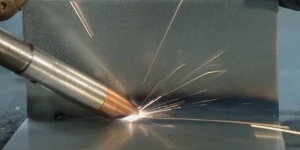Industrial laser welding innovations have revolutionized the manufacturing industry, providing manufacturers with a range of advantages offered by innovative fiber laser welder designs. These advancements have significantly improved the efficiency, precision, and quality of welding processes, resulting in increased productivity and cost savings.
By delivering high-speed and high-power welding capabilities, fiber laser welders enable manufacturers to complete tasks more quickly, reducing production cycles and increasing overall output. Moreover, their precision and accuracy ensure seamless welds with minimal defects, guaranteeing the integrity and durability of the final product.
In this discussion, we will explore the benefits and applications of these innovative fiber laser welder designs, shedding light on how they empower manufacturers in the ever-evolving world of industrial laser welding.
Key Takeaways
- Evolution and advancements in laser welding have led to improved precision, control, and speed.
- Innovative fiber laser welder designs address key challenges faced by manufacturers, such as heat and energy management, welding speed and productivity, and joint access and alignment.
- Laser welding innovations enhance efficiency and productivity through increased welding speed, improved quality with minimal distortion, enhanced automation capabilities, and precise welding operations with minimal human error.
- Laser welding innovations offer cost-saving solutions for manufacturers by reducing material waste, manufacturing time, and the need for multiple welding systems, while also minimizing downtime and maintenance costs.
The Evolution of Industrial Laser Welding
The Evolution of Industrial Laser Welding has revolutionized the manufacturing industry, enhancing precision, efficiency, and overall productivity. Laser welding, a process that utilizes a highly concentrated beam of light to join materials together, has undergone significant advancements since its inception. Initially, laser welding was limited to specific applications due to its high cost and limited capabilities. However, with the advent of innovative fiber laser welder designs, the technology has become more accessible and versatile.
One key aspect of the evolution of industrial laser welding is the development of fiber lasers. These lasers use optical fibers to deliver the laser beam to the workpiece, providing greater flexibility and control. The use of fiber lasers has significantly improved the precision of laser welding, allowing manufacturers to achieve welds with minimal heat distortion and narrow heat-affected zones. This level of precision is particularly important in industries where tight tolerances are required, such as aerospace and medical device manufacturing.
Furthermore, the evolution of industrial laser welding has led to improvements in efficiency. Modern fiber laser welders offer high beam quality and power density, allowing for faster welding speeds and increased throughput. This increased efficiency translates to reduced production times and costs for manufacturers.
Key Challenges Faced by Manufacturers in Laser Welding
Manufacturers in laser welding often encounter various challenges that can impact the efficiency and quality of their welding processes. These challenges arise from the complexity and precision required in laser welding technology. Here are three key challenges faced by manufacturers in laser welding:
- Heat and energy management: Laser welding generates high temperatures, which can lead to distortions, warping, and material damage. Manufacturers must carefully manage and control heat input to ensure the integrity of the welded joint and prevent overheating.
- Welding speed and productivity: While laser welding offers high precision and accuracy, it can be time-consuming compared to conventional welding methods. Manufacturers need to optimize welding speed and productivity to meet production demands while maintaining quality standards.
- Joint access and alignment: Laser welding often requires precise joint access and alignment, especially in complex geometries or hard-to-reach areas. Manufacturers face challenges in ensuring proper joint fit-up and alignment, which can affect the quality and strength of the weld.
To overcome these challenges, manufacturers are continually innovating and developing new techniques and technologies. Advancements in laser welding systems, such as fiber laser welders, offer improved control, faster processing speeds, and enhanced joint access capabilities. These innovations empower manufacturers to overcome challenges and achieve higher efficiency, productivity, and quality in their laser welding processes.

Benefits of Innovative Fiber Laser Welder Designs
After addressing the challenges faced by manufacturers in laser welding, it is important to explore the benefits that innovative fiber laser welder designs can offer. These designs have revolutionized the welding industry by providing numerous advantages over traditional welding methods.
One of the key benefits of innovative fiber laser welder designs is their high precision. These machines are capable of producing welds with exceptional accuracy, ensuring that the final product meets the strictest quality standards. This level of precision is especially important in industries such as aerospace and automotive, where even the smallest imperfections can have significant consequences.
In addition to precision, innovative fiber laser welder designs also offer increased efficiency. These machines are able to weld at higher speeds, reducing the overall production time and increasing the productivity of manufacturers. This not only allows for faster turnaround times but also helps to lower operational costs.
Another advantage of innovative fiber laser welder designs is their versatility. These machines can be used to weld a wide range of materials, including metals, plastics, and composites. This flexibility enables manufacturers to handle diverse projects without the need for multiple welding systems, saving both time and resources.
Furthermore, innovative fiber laser welder designs are known for their reliability and durability. These machines are built to withstand the demands of industrial environments, ensuring consistent performance and minimizing downtime. This reliability is crucial for manufacturers who rely on continuous production to meet customer demands.
Enhancing Efficiency and Productivity Through Laser Welding Innovations
Enhancing efficiency and productivity in manufacturing processes is a critical goal for industries utilizing laser welding innovations. By incorporating the latest advancements in laser welding technology, manufacturers can achieve significant improvements in their production capabilities.
Here are three ways laser welding innovations can enhance efficiency and productivity:
- Increased Speed: Laser welding technology allows for faster welding speeds compared to traditional methods. The precise and focused beam of the laser enables rapid heating and cooling of the material, resulting in shorter welding cycles. This increased speed translates to higher production rates, reducing overall manufacturing time.
- Improved Quality: Laser welding offers exceptional precision and control, leading to superior weld quality. The focused heat input minimizes distortion and reduces the need for post-welding treatments, such as grinding or polishing. This not only saves time but also ensures consistent and reliable welds, improving the overall quality of the manufactured products.
- Enhanced Automation: Laser welding innovations have made significant advancements in automation capabilities. Integration with robotic systems allows for seamless and precise welding operations, minimizing human error and maximizing throughput. Automated laser welding systems can perform complex welds with high repeatability, enabling manufacturers to optimize their production lines and increase productivity.
Cost-Saving Solutions for Manufacturers With Laser Welding Innovations
Incorporating laser welding innovations can provide manufacturers with cost-saving solutions that optimize production processes and improve overall efficiency. Laser welding technology offers several advantages that contribute to reducing costs in manufacturing operations.
One of the primary cost-saving benefits of laser welding is its high precision and accuracy. Laser beams can be precisely controlled to create strong and reliable welds, minimizing material waste and reducing the need for rework or repairs. This precision also allows for the use of thinner materials, which can lead to significant cost savings in terms of material usage and transportation.
Additionally, laser welding offers faster processing speeds compared to traditional welding methods. The high energy density of laser beams enables rapid heating and cooling of materials, resulting in shorter production cycles. This increased productivity translates into cost savings by reducing labor costs and increasing throughput.
Furthermore, laser welding eliminates the need for consumables such as filler materials or shielding gases, which are often required in other welding processes. This eliminates the associated costs and waste generated by these consumables, further contributing to cost savings.
Future Trends and Advancements in Industrial Laser Welding
The future of industrial laser welding is marked by a continuous pursuit of new advancements and trends in the field. As technology continues to evolve, so does the potential for innovative applications and improvements in laser welding processes. Here are three future trends and advancements to keep an eye on:
- Increased Automation: Automation is becoming more prevalent in all areas of manufacturing, and laser welding is no exception. Advancements in robotics and artificial intelligence are allowing for more precise and efficient laser welding processes. Automated systems can work faster and with higher accuracy, resulting in increased productivity and reduced costs.
- Integration of IoT and Data Analytics: The Internet of Things (IoT) is revolutionizing industries, and laser welding is not immune to its impact. By integrating IoT devices and sensors into laser welding machines, manufacturers can collect real-time data on various parameters such as temperature, pressure, and speed. This data can then be analyzed using advanced analytics tools to optimize the welding process, improve quality control, and identify potential issues before they become problems.
- Advancements in Laser Sources: The development of new laser sources, such as fiber lasers, is driving advancements in laser welding. Fiber lasers offer higher power and beam quality, allowing for faster and more precise welding. Additionally, advancements in laser diode technology are making laser welding more affordable and accessible to a wider range of manufacturers.
These future trends and advancements in industrial laser welding hold great promise for manufacturers, enabling them to achieve higher productivity, improved product quality, and greater cost savings. By staying informed and embracing these innovations, manufacturers can position themselves at the forefront of the industry and gain a competitive edge.
Frequently Asked Questions
How Has Industrial Laser Welding Evolved Over Time?
Industrial laser welding has evolved significantly over time, with advancements in technology and design. These innovations have led to increased precision, efficiency, and quality in the welding process, empowering manufacturers to achieve higher levels of productivity and profitability.
What Are Some of the Key Challenges That Manufacturers Face in Laser Welding?
Some key challenges that manufacturers face in laser welding include achieving consistent weld quality, optimizing process efficiency, managing heat distortion, and ensuring proper joint fit-up and alignment.
What Are the Benefits of Using Innovative Fiber Laser Welder Designs?
Innovative fiber laser welder designs offer numerous advantages for manufacturers. These designs provide higher precision, faster welding speeds, improved energy efficiency, and the ability to weld a wider range of materials, resulting in increased productivity and cost savings.
How Can Laser Welding Innovations Enhance Efficiency and Productivity?
Laser welding innovations can enhance efficiency and productivity by providing faster and more precise welds, reducing production time and costs. Innovative fiber laser welder designs offer advanced features such as automatic calibration and real-time monitoring, further improving overall performance and quality.
Are There Any Cost-Saving Solutions for Manufacturers With Laser Welding Innovations?
Yes, there are cost-saving solutions for manufacturers with laser welding innovations. These innovations, such as fiber laser welder designs, offer increased efficiency and productivity, leading to reduced production costs and improved profitability.
Conclusion
In conclusion, the advancements in fiber laser welder designs have revolutionized the manufacturing industry by offering high-speed, high-power capabilities that increase efficiency and productivity. The precision and accuracy of these welders ensure seamless welds with minimal defects, enhancing the integrity and durability of the final product. Additionally, their compact size and flexibility make them suitable for various applications, optimizing workflow and operational efficiency. These innovations have empowered manufacturers to achieve higher levels of productivity, precision, and cost-effectiveness in their welding processes.
You May Also Like:

